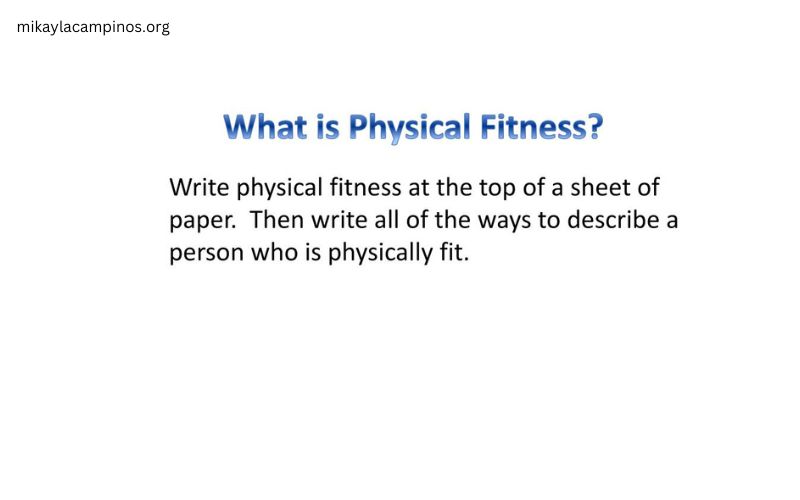Physical fitness is a state of overall well-being and the ability to perform daily tasks and activities with ease, energy, and vigor. It encompasses a range of physical attributes, including cardiovascular endurance, muscular strength and endurance, flexibility, and body composition. Being physically fit means that your body is capable of handling the demands of everyday life, as well as more strenuous physical challenges, without undue fatigue or strain.
Components of Physical Fitness
Physical fitness is typically broken down into the following components:
- Cardiovascular Endurance: The ability of the heart, lungs, and blood vessels to work efficiently and deliver oxygen to the muscles during sustained physical activity.
- Muscular Strength: The maximum force a muscle or muscle group can exert against a resistance.
- Muscular Endurance: The ability of a muscle or muscle group to perform repeated contractions against a resistance for an extended period of time.
- Flexibility: The range of motion around a joint or series of joints.
- Body Composition: The ratio of fat mass to lean muscle mass in the body.
Importance of Physical Fitness
Physical fitness is essential for maintaining overall health and well-being. It helps to reduce the risk of chronic diseases, such as heart disease, diabetes, and certain types of cancer. Regular physical activity also helps to improve mental health, boost energy levels, and enhance your quality of life.
Benefits of Physical Fitness
Engaging in regular physical activity can provide a wide range of benefits, including:
- Improved cardiovascular health and reduced risk of heart disease
- Better management of chronic conditions, such as high blood pressure and type 2 diabetes
- Stronger muscles and bones, which can help to prevent falls and fractures
- Enhanced mood and reduced symptoms of depression and anxiety
- Increased energy levels and improved sleep quality
- Better weight management and a healthier body composition
How to Assess Physical Fitness
There are several ways to assess your physical fitness level, including:
- Cardiovascular fitness tests, such as the 1-mile run or the 12-minute walk/run test
- Muscular strength and endurance tests, such as push-ups, sit-ups, and grip strength tests
- Flexibility tests, such as the sit-and-reach test
- Body composition assessments, such as body mass index (BMI) or body fat percentage measurements
Types of Physical Fitness Activities
There are many different types of physical fitness activities that you can engage in, including:
- Aerobic activities, such as walking, running, cycling, swimming, and dancing
- Strength-training activities, such as weightlifting, resistance band exercises, and bodyweight exercises
- Flexibility activities, such as stretching, yoga, and Pilates
- Balance and coordination activities, such as tai chi and certain types of dance
Tips for Improving Physical Fitness
Here are some tips to help you improve your physical fitness:
- Set realistic goals and create a plan to achieve them.
- Gradually increase the intensity and duration of your workouts over time.
- Incorporate a variety of activities into your routine to keep things interesting and challenge different muscle groups.
- Listen to your body and allow for rest and recovery between workouts.
- Stay hydrated and fuel your body with a balanced, nutrient-rich diet.
Nutrition and Physical Fitness
Proper nutrition is essential for supporting physical fitness. Eating a balanced diet that includes a variety of nutrient-dense foods, such as fruits, vegetables, whole grains, lean proteins, and healthy fats, can help to:
- Provide the energy and nutrients your body needs to perform at its best
- Support muscle growth and recovery
- Maintain a healthy body weight and composition
- Reduce the risk of chronic diseases
Common Misconceptions about Physical Fitness
There are several common misconceptions about physical fitness that are important to address:
- “You have to be an athlete to be physically fit.” This is not true – physical fitness is achievable for people of all fitness levels and abilities.
- “Cardio is the only way to get fit.” While cardiovascular exercise is important, strength training and flexibility training are also essential components of a well-rounded fitness routine.
- “No pain, no gain.” While some discomfort is normal during physical activity, excessive pain or injury is a sign that you need to adjust your workout or seek medical attention.
Conclusion
Physical fitness is a multifaceted concept that encompasses a range of physical attributes, including cardiovascular endurance, muscular strength and endurance, flexibility, and body composition. Engaging in regular physical activity and maintaining a balanced, nutrient-rich diet can provide a wide range of physical and mental health benefits.
To get started on your journey to improved physical fitness, consider working with a certified personal trainer or fitness coach. They can help you develop a customized workout plan and provide guidance on nutrition and lifestyle changes to support your goals. Don’t wait – take the first step towards a healthier, more active you today!



